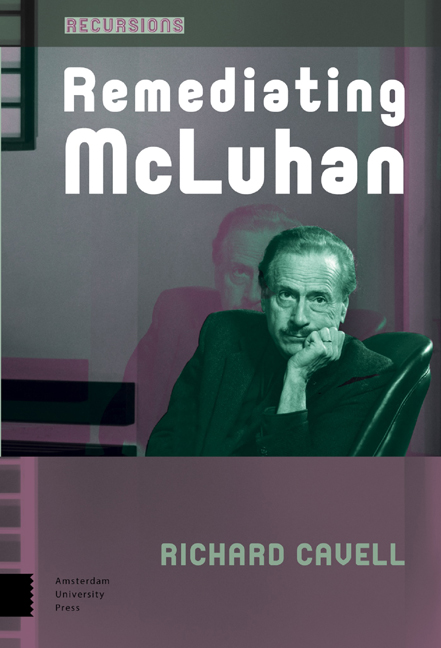Book contents
- Frontmatter
- Dedication
- Contents
- Introduction
- List of sigla
- I
- Re: Mediation
- 1 Beyond McLuhanism
- 2 McLuhan and the Question of the Book
- Embodiment as Incorporation
- 3 McLuhan and the Body as Medium
- 4 McLuhan, Tactility, and the Digital
- 5 Mechanical Brides and Vampire Squids
- Empathic Media
- 6 McLuhan: Motion: e-Motion: Towards a Soft Ontology of Media
- 7 Re-Mediating the Medium
- Determining Technology
- 8 McLuhan, Turing, and the Question of Determinism
- 9 Angels and Robots
- Being Mediated
- 10 Marshall McLuhan’s Echo-Criticism
- 11 McLuhan and the Technology of Being
- II
- 12 The Tragedy of Media: Nietzsche, McLuhan, Kittler
- Coda: On the 50th Anniversary of Understanding Media
- Notes
- Works Cited
- Index
3 - McLuhan and the Body as Medium
Published online by Cambridge University Press: 12 December 2020
- Frontmatter
- Dedication
- Contents
- Introduction
- List of sigla
- I
- Re: Mediation
- 1 Beyond McLuhanism
- 2 McLuhan and the Question of the Book
- Embodiment as Incorporation
- 3 McLuhan and the Body as Medium
- 4 McLuhan, Tactility, and the Digital
- 5 Mechanical Brides and Vampire Squids
- Empathic Media
- 6 McLuhan: Motion: e-Motion: Towards a Soft Ontology of Media
- 7 Re-Mediating the Medium
- Determining Technology
- 8 McLuhan, Turing, and the Question of Determinism
- 9 Angels and Robots
- Being Mediated
- 10 Marshall McLuhan’s Echo-Criticism
- 11 McLuhan and the Technology of Being
- II
- 12 The Tragedy of Media: Nietzsche, McLuhan, Kittler
- Coda: On the 50th Anniversary of Understanding Media
- Notes
- Works Cited
- Index
Summary
Contemporary media studies are said to be in crisis. The advent of the ‘new’ media has provoked the question of how the new media differ from the ‘old’, mass media. Some, such as Bernhard Siegert, have responded that there are no mass media. Siegert's argument is that what was massified in mediation were material objects, such as television sets, whereas mediation has more to do with transmission. Others, such as Eva Horn, push Siegert’s argument further, stating that ‘[t]here are no media’ (‘Introduction’, p. 1), and argue that a fixed concept of media has been superseded by the new media, which have become such a part of our lives that media theorists can only study their effects.
As Wendy H.K. Chun notes in her introduction to New Media / Old Media, the term ‘new media’ gained prominence in the mid-1990s and was meant to signal a radical break from mass media such as television; what really sets the new media apart, according to Chun, is the element of interactivity. There are a number of problems with this staking out of ‘new’ media territory, however. Firstly, the ‘old’ mass media are still going strong; television's hegemony has not been overturned by the new media. Rather, television has been remediated— we now watch TV on the internet. TV still retains the lion's share of people's free time, but they watch it alongside over one billion unique viewings of YouTube per month. What this points to is a media ecology, one in which media interact and interrelate; it is becoming less possible to understand media in isolation. Secondly, interactivity was identified as an aspect of mass media by McLuhan half a century ago; in fact, what associates television with the other two screens that dominate our lives today—the one on the computer and the one on the mobile device (where video accounts for more than 50 per cent of all traffic)—is universally acknowledged to be its ‘immersive’ quality (Stross, ‘While Television Still Shines’).
To address these complexities and the contested theories about them, Chun does what most academics would do—she turns to the dictionary and looks up the word ‘media’. ‘According to the Oxford English Dictionary,’ she writes, ‘media stems from the Latin medium meaning middle, center, midst.
- Type
- Chapter
- Information
- Remediating McLuhan , pp. 41 - 48Publisher: Amsterdam University PressPrint publication year: 2016



